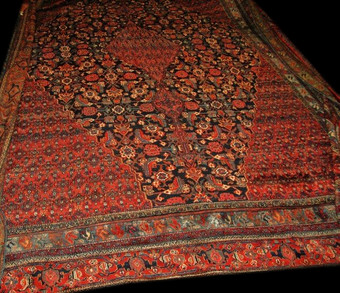Antique handmade oversized carpet No. 57546 Bijar, ca. 1890 Iran 560 x 380 cm

Larger images (will open in new window)
Please click on the thumbnails below for a larger view
| main view |
second total |
third total |
close-up |
close-up of corner |
 |
 |
 |
 |
 |
| back |
 |
| Item Number: |
57546 |
| Name: |
Bijar, ca. 1890 |
| Country of Origin: |
Iran |
| Size: |
560 x 380 cm |
| Made:
|
ca. 1890 |
| Pile: |
wool |
| Design: |
geometric / medallion |
| Ground Color: |
dark blue / navy |
| Remarks: |
This is a unique handmade / hand-knotted / traditional oriental carpet
The pile of this carpet is made of wool
Perfect condition with high pile, fine, shiny wool |
 add to cart
add to cart
More about the provenance Bijar, ca. 1890 | Iran
The provenance is Bijar, North West of Iran. Bijar rugs are mainly knotted by Kurds who are the main population of Bijar (in the province of Kermanshah). Bijar carpets are known to be the most solid and high quality Oriental carpets.
The wool of this rug has been dyed with vegetable dyes only which became very rare in Oriental rugs. Since ca. 1850 synthetic dyes found their way into carpet production. Ever since they replaced natural vegetable dyes more and more also due to the fact that the production of vegetable dyes is very time consuming and difficult. But the "aura of genuineness" can be reached to its full extent with vegetable dyes only. Vegetable dyes are made from leaves, flowers, branches, fruits and roots. They give Oriental rugs a particularly harmonic look. In general Oriental rugs "age" better and more beautifully with vegetable dyes than with synthetic dyes plus they increase a carpet's value. Most of today's production is made with synthetic dyes which makes this rug an even more desirable piece. Unfortunately many rugs in the market are being labelled as being vegetable dyed which in many colors is simply not true which damages the reputation of the carpet industry altogether.
This Bijar, ca. 1890 has a "Herati" or "Mahi" design (has its origin in Herat, ca. 16th century, short for "Mahi to Hos" meaning "fish in the pond"). A rosette is surrounded by a rhombus which is again surrounded by four bent leaves. The name "Mahi" meaning "fish" was given to this design because the leaves resemble swimming fish.

